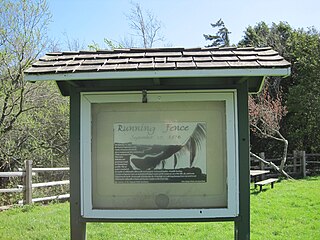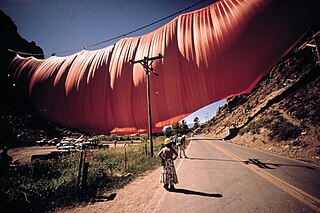Related Research Articles

Land art, variously known as Earth art, environmental art, and Earthworks, is an art movement that emerged in the 1960s and 1970s, largely associated with Great Britain and the United States but that also includes examples from many countries. As a trend, "land art" expanded boundaries of art by the materials used and the siting of the works. The materials used were often the materials of the Earth, including the soil, rocks, vegetation, and water found on-site, and the sites of the works were often distant from population centers. Though sometimes fairly inaccessible, photo documentation was commonly brought back to the urban art gallery.

The Reichstag, a historic legislative government building on Platz der Republik in Berlin, is the seat of the German Bundestag. It is also the meeting place of the Federal Convention, which elects the President of Germany.

The Gates were a group of gates comprising a site-specific work of art by Bulgarian artist Christo Yavacheff and French artist Jeanne-Claude, known jointly as Christo and Jeanne-Claude. The artists installed 7,503 vinyl "gates" along 23 miles (37 km) of pathways in Central Park in New York City. From each gate hung a panel of deep saffron-colored nylon fabric. The exhibit ran from February 12 through February 27, 2005.

Christo Vladimirov Javacheff (1935–2020) and Jeanne-Claude Denat de Guillebon (1935–2009), known as Christo and Jeanne-Claude, were artists noted for their large-scale, site-specific environmental installations, often large landmarks and landscape elements wrapped in fabric, including the Wrapped Reichstag, The Pont Neuf Wrapped, Running Fence in California, and The Gates in New York City's Central Park.
Events from the year 1969 in art.

Little Bay is a suburb in the Eastern Suburbs of Sydney, in the state of New South Wales, Australia. Little Bay is located 14 kilometres south-east of the Sydney central business district and is part of the local government area of the City of Randwick.
Events from the year 1935 in art.

Running Fence was an installation art piece by Christo and Jeanne-Claude, which was completed on September 10, 1976. The art installation was first conceived in 1972, but the actual project took more than four years to plan and build. After it was installed, the builders removed it 14 days later, leaving no visible trace behind.

The Kunsthalle Bern is a Kunsthalle on the Helvetiaplatz in Bern, Switzerland.
Kaldor Public Art Projects is an Australian non-profit arts organisation established in 1969 by John Kaldor. The organisation collaborates with international artists to create site-specific art projects in public spaces in Australia.

John William Kaldor is an Australian art collector, philanthropist, and the founder of Kaldor Public Art Projects.

The Floating Piers was a temporary, site-specific work of art by Christo and Jeanne-Claude, consisting of 70,000 square meters of yellow fabric, carried by a modular floating dock system of 226,000 high-density polyethylene cubes installed in 2016 at Lake Iseo near Brescia, Italy. The fabric created a walkable surface between Sulzano, Monte Isola and the island of San Paolo.
L'Arc de Triomphe, Wrapped, known as "L'Arc de Triomphe Empaqueté" in French, was a temporary art installation by artists Christo and Jeanne-Claude where the Arc de Triomphe in Paris was wrapped in a silver-blue fabric and red rope for two weeks in 2021.

Wrapped Reichstag, Project for Berlin is a 1995 environmental artwork by artists Christo and Jeanne-Claude included as the wrapped up Berlin Reichstag building in fabric.

Valley Curtain was a 1972 environmental artwork in which artists Christo and Jeanne-Claude raised an orange curtain of fabric across a mountainous span of Colorado State Highway 325. Preparations began within a year of their Australian Wrapped Coast. The artists formed a corporation to benefit from tax and other liabilities, a form they used for later projects. Following a failed attempt to mount the curtain in late 1971, a new engineer and builder-contractor raised the fabric in August 1972. The work only stood for 28 hours before the wind again destroyed the fabric. This work, their most expensive to date and first to involve construction workers, was captured in a documentary by David and Albert Maysles. Christo's Valley Curtain was nominated for Best Documentary Short in the 1974 Academy Awards.
The Pont Neuf Wrapped, Paris, 1975–1985 was a 1985 environmental artwork in which artists Christo and Jeanne-Claude wrapped the Pont Neuf in fabric. Planning for the project started in 1979. The artists put a model of the project in the window of La Samaritaine, a department store close to the bridge, in late 1981. Paris Mayor Jacques Chirac rejected the project in early 1982. An aide to the mayor snuck the permit approval into a pile of the mayor's papers, which he signed inadvertently in August 1984. When the mayor attempted to repeal the approval, Jeanne-Claude said she would show the press the letter as a symbol of his signature's worth, after which he dropped his case. In September 1985, the artists wrapped the bridge and its 44 streetlamps in a sandstone-colored fabric. The two-week installation attracted three million visitors. Artsy described the response as "sensational".
Surrounded Islands, Biscayne Bay, Greater Miami, Florida, 1980–83 was a 1983 environmental artwork in which artists Christo and Jeanne-Claude surrounded an island archipelago in Miami with pink fabric.

The Umbrellas, Japan–USA, 1984–91 was a 1991 environmental artwork in which artists Christo and Jeanne-Claude erected yellow and blue umbrella structures in California and Japan, respectively. The 3,100-umbrella project cost US$26 million and attracted three million visitors. Christo closed the exhibition early after a woman was crushed by a windswept umbrella in California. Separately, a worker was killed during the deconstruction of the Japanese exhibit.
Over the River was an unrealized installation artwork by Christo and Jeanne-Claude that would have suspended silver fabric over six miles of Colorado's Arkansas River. Artsy described the work as the duo's most notable unrealized work.

Jan van der Marck was a Dutch-born American museum administrator, art historian, and curator, focused on modern and contemporary art. Van der Marck authored and published many essays, articles and books about artists and art.
References
- ↑ Christo; Shunk-Kender (1969). Christo: Wrapped Coast, One Million Square Feat. Minneapolis: Contemporary Art Lithographers.